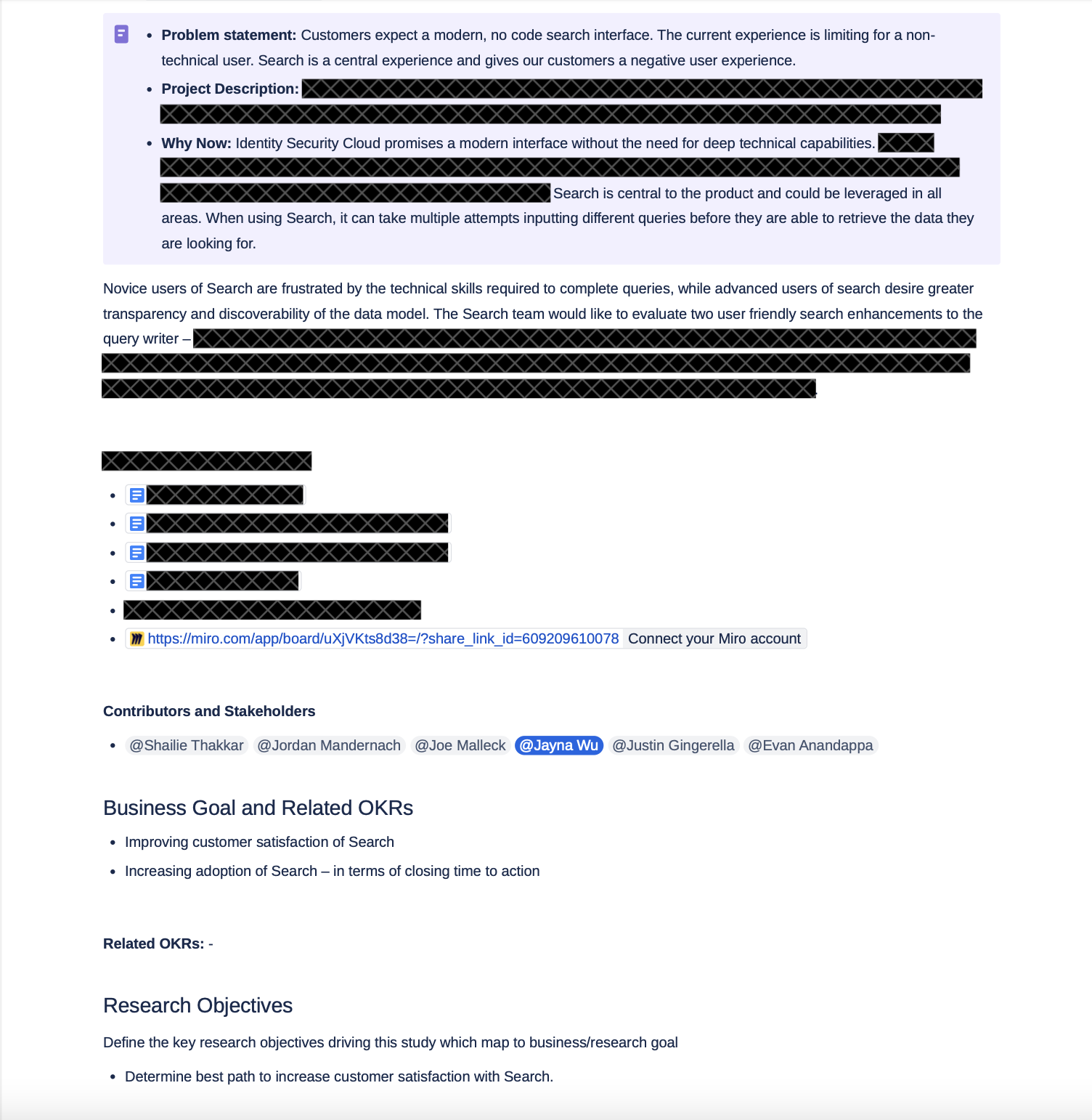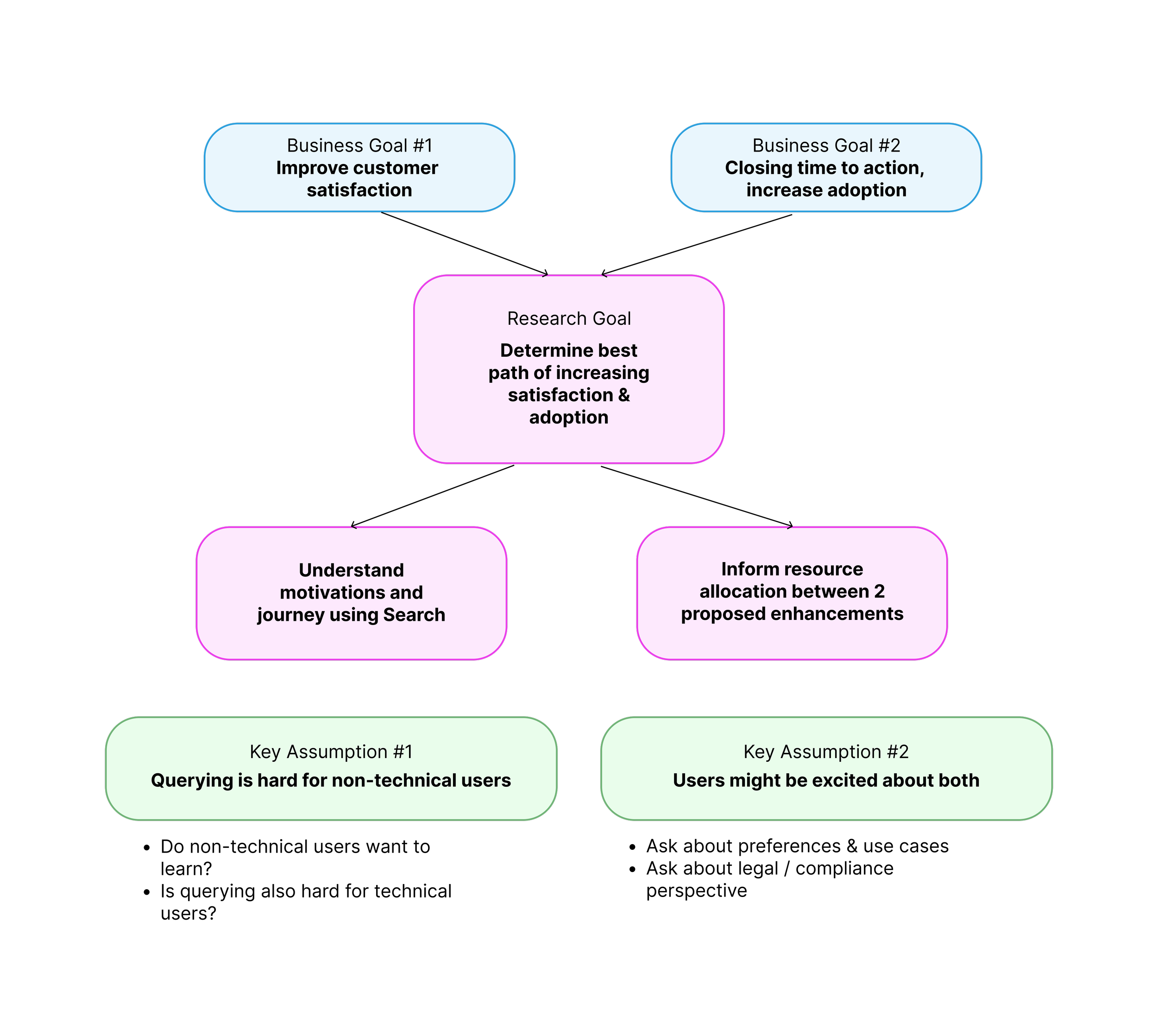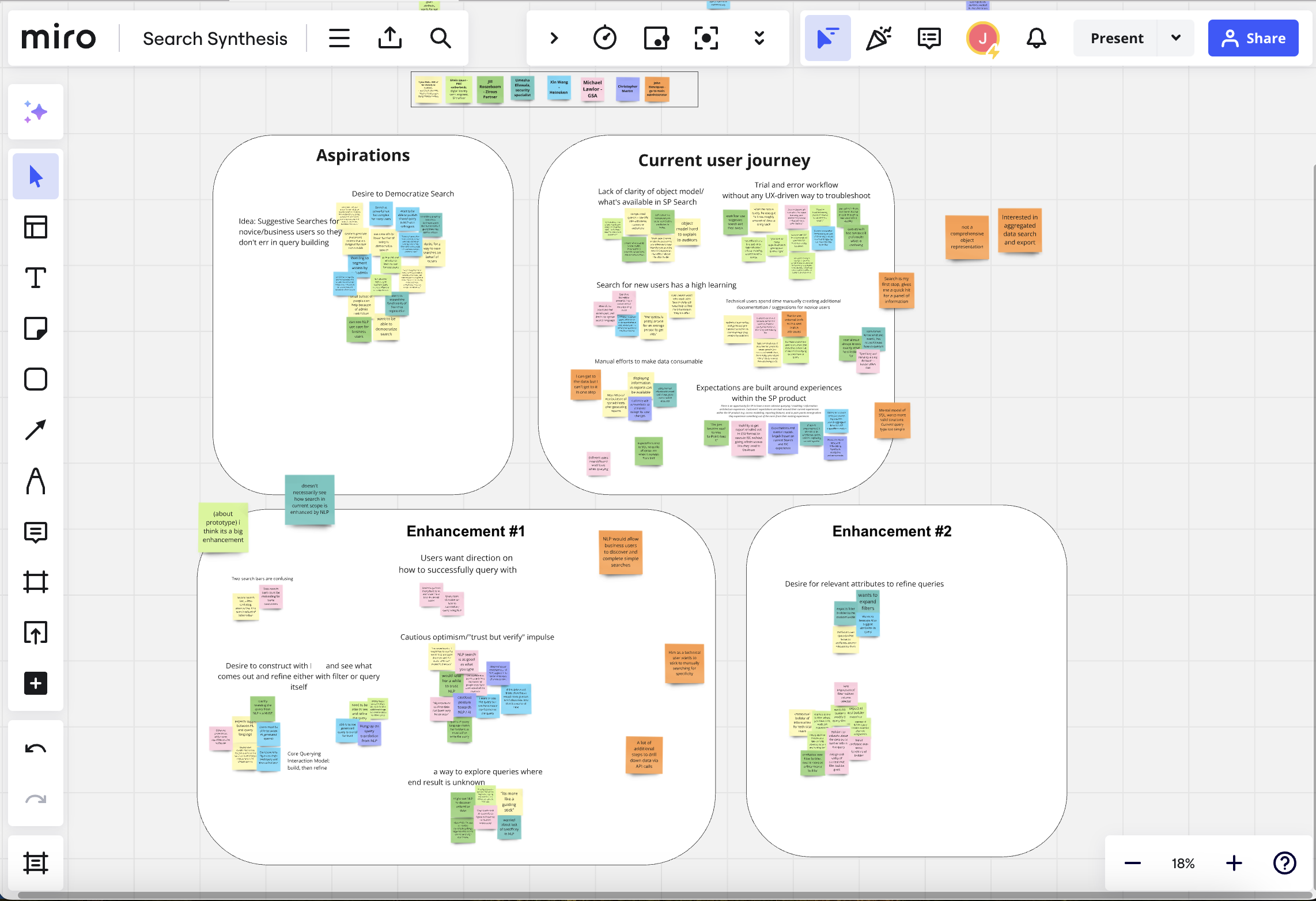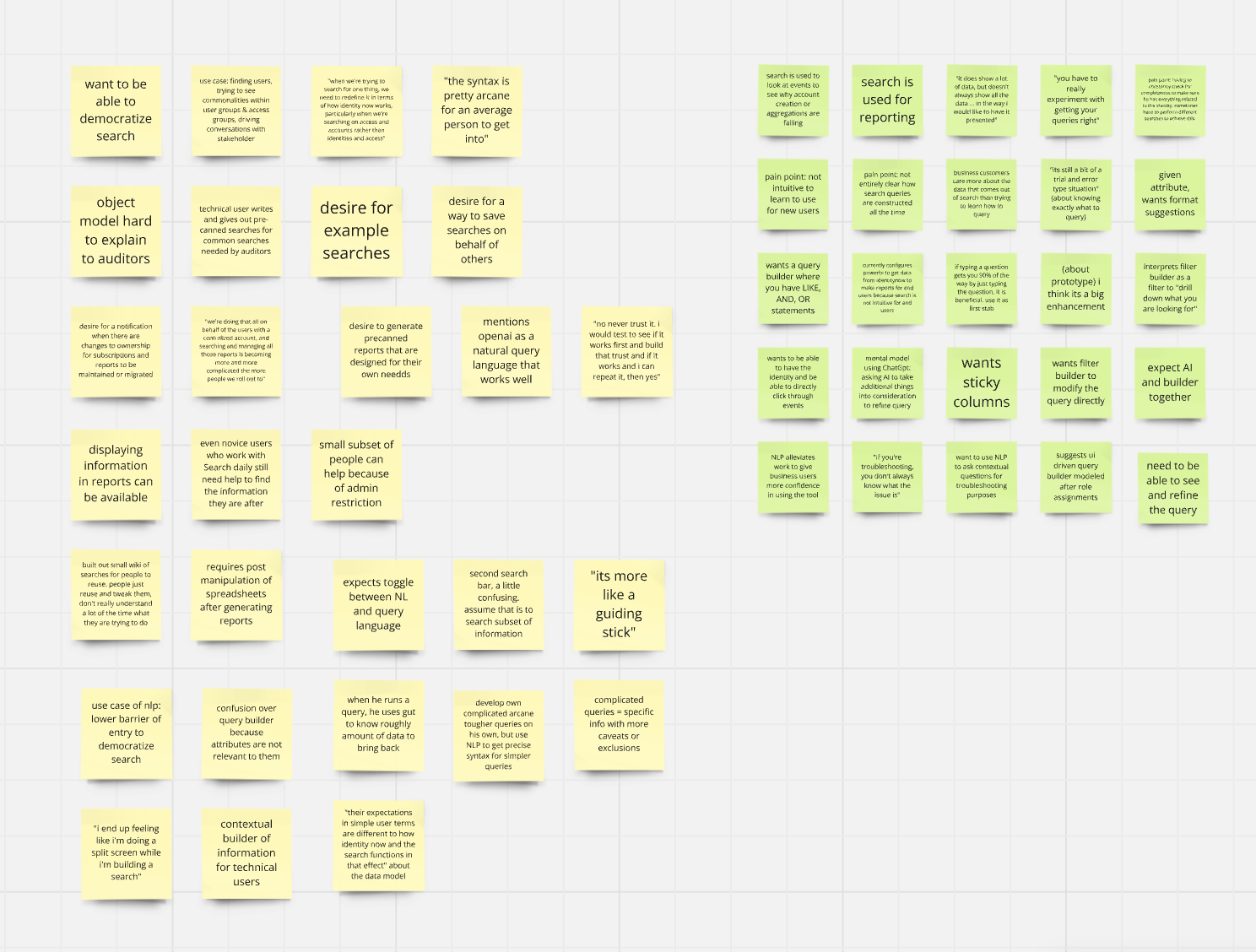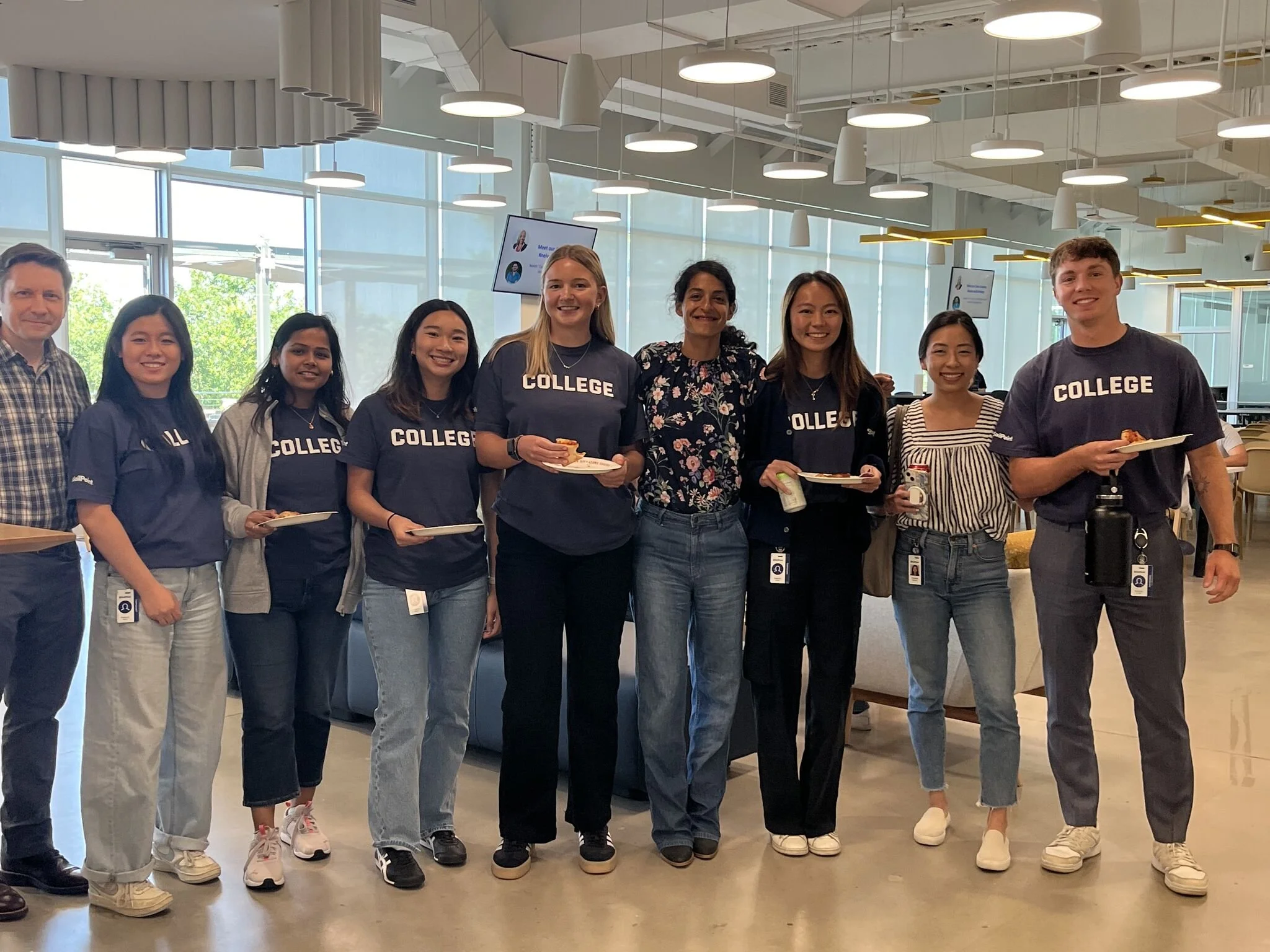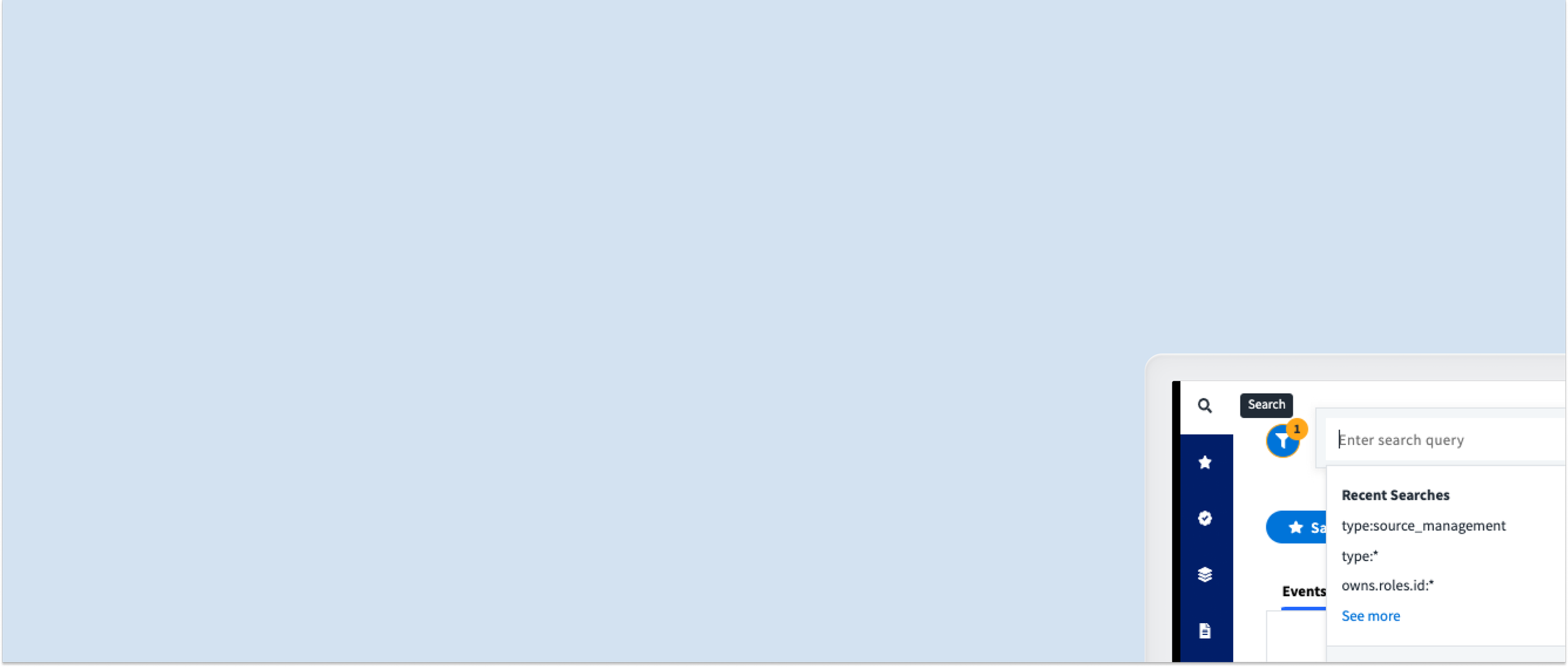
Driving no-code Search interface enhancements for a cohesive SailPoint platform experience
Timeline
Summer 2024
Team
2 UXR, 1 Design, 1 PM, 1 UX Architect
Role
Lead Researcher
Tools + Craft
Participant Recruitment via Pendo, User Interviews, Prototype Testing, Affinity Mapping via Miro
PROJECT OVERVIEW
PROBLEM SCOPE
MY ROLE
SailPoint’s ISC is a cloud-based platform that promises the ability to govern identities through a modern interface without the need for deep technical capabilities. The current Search experience, however, requires deep querying knowledge and therefore has a high barrier of entry for both technical and non-technical users.
Our task was to discover customers’ querying journey to validate and iterate on 2 proposed enhancements to the Search interface, and inform resource allocation and product roadmap of these enhancements.
As the lead researcher, I spearheaded cross functional collaboration between UXR, PM, Design & UX architect to align on the desired outcomes of the research. I worked closely with product stakeholders to develop a research and outreach plan, facilitated participant recruitment and the completion of 10 interviews. I also streamlined synthesis through collaborative affinity mapping before synthesizing the main themes and opportunities that surfaced.
PROBLEM STATEMENT
How might we improve customer satisfaction and adoption of Search through improving the querying experience with low-code modern interface enhancements?
OUR PROCESS
🤝🏻 Stakeholder Alignment
Alignment of key business and research goals within cross functional team to craft research plan
💬 Recruitment
Conducted A/B testing of popup vs static button on Pendo. Recruited and scheduled 14 customer interviews in 2 days.
📍 Interviews
Conducted 10 interviews and prototype tests
🖍️ Synthesis
Collaborated with stakeholders to conduct affinity mapping
P.S. THIS PROJECT IS NOT PUBLICLY AVAILABLE YET :( THIS WILL DETAIL MY THOUGHT PROCESS, BUT IF YOU WANT MORE SPECIFICS ON INSIGHTS PLEASE EMAIL ME!
LET’S REWIND..
Stakeholder Alignment
Narrowing our scope
SailPoint’s Search function is widely used within the product beyond the Search interface, and is the central hub for many customers and professional services for retrieving necessary data to successfully govern identities within their enterprise. The ubiquitous usage of Search, the wide variety of verticals SailPoint serves, and the differing stages of identity governance customers are in have resulted in many use cases and improvement requests that the product team must prioritize in their roadmap.
To narrow our scope, I initiated stakeholder discussions regarding:
Key business goals
What we want to find out & what we will not find out
Our key assumptions
Listening to the PM, Design and UX Architect on my team brainstorm and discuss these allowed me to better understand prior work done, get a sense of their perceived customer sentiments, and where their priorities with Search lay!
Crafting a Research Plan
Because this project kicked off close to the end of my internship, I only had 4 weeks to complete my research.
Based on the key business and research objectives set out during our discussion, I chose to use moderated interviews and prototype testing.
This allowed me to actively engage with the participant, and for stakeholders on the call to jump in and probe on certain lines of thought! I saw great value in UXR, PM, Design and Engineering collectively empathizing with the user journey, as well as the different perspectives from which each person from the team can dig deeper into insights found during interviews.
Prototype testing also provided a great medium through which we could gauge organic impressions and interactions to each proposed enhancement, which would allow us to identify preferences and opportunities for improvements
Before beginning recruitment, I sent my research plan to the rest of the team for feedback, and worked together with the Senior Researcher to iterate on the questions.
Recruitment
I used Pendo to conduct in-platform recruitment of SailPoint admins for my interviews to ensure a variety of customers and mitigate as much bias as we could. I included news of proposed enhancements in the messaging as a feeler of customer interest in the enhancement.
In deciding between a pop-up and a static button, I decided to conduct a small A/B test to better inform future recruitment efforts in Search. I found that the pop-up had a ~20% higher response rate than the button, but a greater percentage of those who clicked the static button actually scheduled time for an interview.
With both the button and the pop-up, we recruited 14 participants within 2 days — a nod towards interest in the enhancement and wide usage of the product!
Interviews & Synthesis
Interviews & Prototype Testing
I conducted 10 moderated interviews and prototype tests over 2 weeks, and invited all stakeholders to each call to observe and ask questions. After each interview, I would record key takeaways from each stakeholder in the call in a master document, and record key quotes on stickies in Miro.
Examples of questions I asked include:
Can you walk me through the last time you used Search?
Tell me about your current experience with Search.
What is missing from your current Search experience?
Can you walk me through your first impressions of this new interface?
Can you imagine completing your last querying with this enhancement?
Collaborative Affinity Mapping
After completing the interviews, I organized a collaborative session with the team to go through the insights and sort them into buckets. I believed this to be useful as each stakeholder has different contexts and priorities with Search, and so having a diversity in perspectives from PM, Design and Engineering lends a well-rounded richness to synthesizing insights. (It was also a way to evangelize research practices within the product organization!)
I then sorted them into 4 distinct buckets, and used these buckets to carve out insights & opportunities in a report.
Insights & Opportunities
I was able to connect insights to the research goal of discovering mental models underlying users interactions & expectations with the current Search experience and how they evaluated the enhancements. Through uncovering how design & PM are currently thinking about the Search experience, I was able to identify short to medium-term design opportunities and product prioritization with the greatest impact on the business goal of customer satisfaction and adoption that can be implemented prior to the launch, as well as long-term opportunities for product messaging and overall vision for the Search experience.
Here is an example of my insights informed my recommendations. Because this project is not yet public, I am unable to share detailed insights here, so please contact me if you want more details!
Impact
Research informed PM & Design decision to prioritize improving & iterating on Enhancement #1. Enhancement will be previewed at Sailpoint’s annual conference in October 2024!
Research also informed decision to pivot design & messaging around Enhancement #2 to focus on data model visibility rather than complex query construction.
Formal confirmation of anecdotal feedback on non-linear user workflow, challenges and aspirations around using Search. This lends further weight to the business decision to invest further in core Search enhancements like query sharing.
My personal reflections…
At the Austin HQ :0
This was my capstone project for my 10 week internship at SailPoint, and I had a lot of fun learning about the identity governance space, and more specifically how enterprises use Search! Enterprise needs and aspirations regarding cybersecurity are not top of mind for the everyday consumer like myself, but I learnt the beauty and power of empathy through conversations with our customers.
Here are some of my key takeaways:
Stakeholder collaboration is so, so powerful!
Each person on the team brought new perspectives with the product, and I initiated many collaborative efforts to understand the priorities of PM, Design and Engineering. This ensured that the research was relevant to answering their unknowns. Evangelism of UX practices through keeping stakeholders in the loop during the data collection phase & collaborative synthesis also increased buy-in to the insights we were gathering, making insights more impactful for PM and Design decision making.
Weighing quality and quantity of insights given a tight time frame
Because of the short time frame, I had to be intentional and efficient about choosing a research and recruitment method that would allow for rich insights from diverse perspectives. Despite the time crunch, we intentionally chose to recruit primarily from Pendo instead of relying completely on go-to customers to ensure we could cast a wide net of verticals, identity security maturity and use cases.
Be confident in facilitation and asking customers what you don’t know
I got a lot of practice organizing and facilitating conducting interviews and prototype tests. I learnt to create a sense of curiosity and space for learning, and asked my questions confidently. I also learnt that it is okay to turn the question around to the customer — ask them what THEY would expect and digging deeper into points you may be unsure of sometimes yields gems that drive insights.
I am so grateful for the mentorship that my buddy Shailie throughout the internship, and for the opportunity to work with the rest of the Search team — Jordan, Joe, Justin and Evan! I would also like to thank Lauren and Jeffrey from the Pricing & Research team for their endless support, guidance and encouragement during the summer and beyond.
